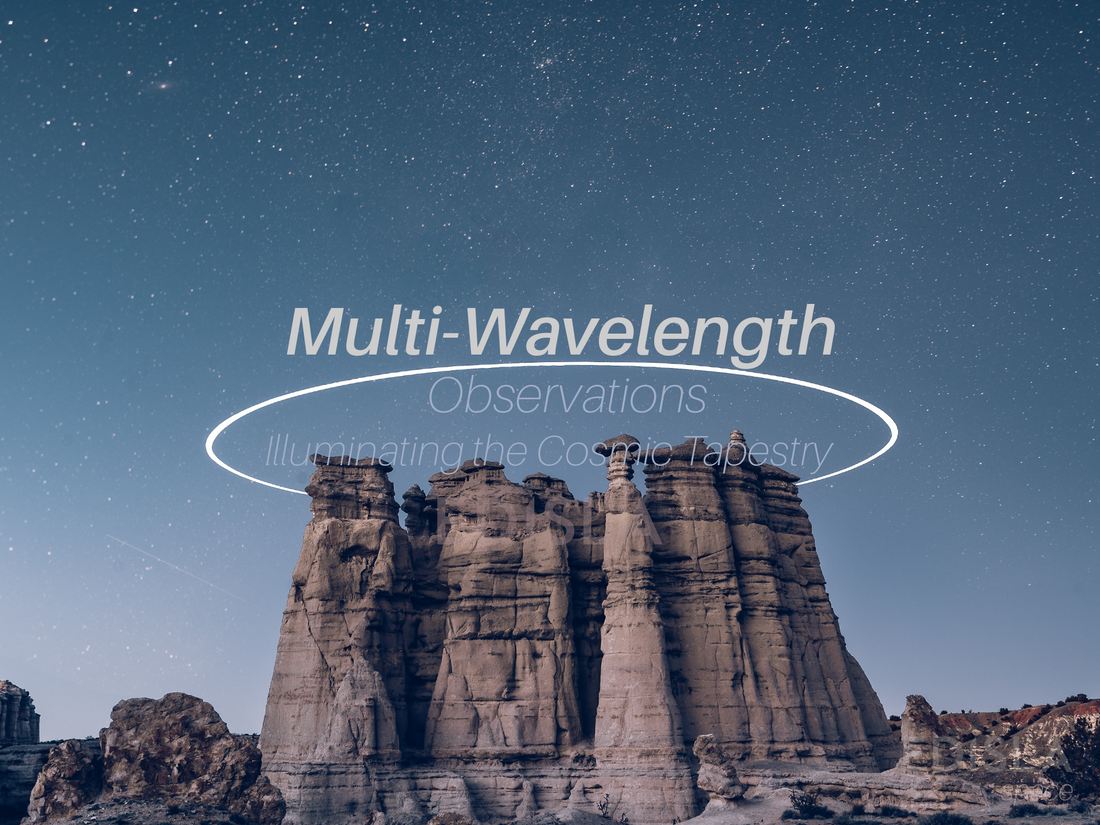
Multi-Wavelength Observations: Illuminating the Cosmic Tapestry
The universe is an expanse of wonder, a tapestry woven with threads of light across a vast spectrum of wavelengths. To unravel its mysteries, scientists employ a powerful technique known as multi-wavelength observations. By harnessing the capabilities of various regions of the electromagnetic spectrum, from radio waves to gamma rays, researchers gain unique perspectives on celestial objects and phenomena. In this elaborate article, we embark on a captivating journey into the world of multi-wavelength observations, exploring the intricacies of each wavelength and the unprecedented detail they unveil about the cosmos, including remarkable discoveries from India.
1. The Spectrum of Light: A Vast and Diverse Range
The electromagnetic spectrum encompasses an extensive range of wavelengths, each with distinct properties and interactions with matter. Starting from the longest wavelength end, we have radio waves, followed by microwave, infrared, visible light, ultraviolet, X-rays, and finally, gamma rays. Each segment offers a different view of the universe, unlocking specific aspects of cosmic phenomena.
2. Radio Observations: Exploring Low-Energy Cosmic Processes
Radio waves, with their long wavelengths, excel at studying low-energy processes in the universe. Radio telescopes, such as the iconic Arecibo Observatory and the upcoming Square Kilometre Array (SKA), allow astronomers to detect and analyze radio emissions from a variety of celestial objects. From the detection of pulsars, spinning neutron stars that emit regular radio pulses, to mapping the cosmic microwave background radiation, the remnants of the Big Bang, radio observations unveil the hidden aspects of the cosmos with sensitivity and precision.
India has made significant contributions to radio astronomy with the establishment of world-class facilities. The Giant Metrewave Radio Telescope (GMRT) located near Pune is one such remarkable facility. With its array of thirty antennas spread across vast distances, the GMRT operates at meter and decimeter wavelengths, enabling scientists to study a wide range of cosmic phenomena. The GMRT has played a pivotal role in unraveling the mysteries of pulsars, exploring active galactic nuclei, and studying the interstellar medium.
3. Microwave and Infrared Observations: Peering Through Cosmic Dust
Moving along the spectrum, we encounter microwave and infrared wavelengths. Microwave observations provide insights into the universe's most ancient light, allowing us to study the cosmic microwave background radiation in detail. Infrared observations, on the other hand, penetrate the dust clouds that obscure visible light, unveiling hidden stellar nurseries, dusty regions of star formation, and even the warm glow of protoplanetary disks where new planetary systems may be forming.
India's first dedicated multi-wavelength space observatory, Astrosat, launched by the Indian Space Research Organisation (ISRO), has made significant contributions in the field of infrared astronomy. Equipped with a suite of instruments capable of observing various wavelengths, including infrared, Astrosat has provided valuable data on a range of cosmic phenomena. It has allowed scientists to study young stars, active galaxies, and the dynamics of compact binary systems.
4. Optical Observations: Unveiling the Visible Universe
The visible light portion of the spectrum has been the backbone of astronomical observations for centuries. Optical telescopes capture stunning images of celestial objects, showcasing the vibrant colors and intricate details of galaxies, stars, and nebulae. These observations reveal the dynamic processes occurring in the visible universe, enabling scientists to study stellar evolution, galaxy formation, and the movements of celestial bodies.
India's contributions in optical astronomy include the 2.34-meter optical telescope at the Vainu Bappu Observatory in Kavalur, Tamil Nadu. The telescope has played a significant role in various observational campaigns, including the study of binary star systems, variable stars, and the detection and characterization of exoplanets.
5. Ultraviolet Observations: Revealing the Hot and Energetic
Ultraviolet light reveals the high-energy processes occurring in the universe. Observations in this wavelength range, carried out by telescopes like the Hubble Space Telescope and the upcoming James Webb Space Telescope, provide valuable insights into the birth and death of stars, the dynamics of interstellar gas, and the ultraviolet signatures of active galactic nuclei. By studying the ultraviolet emissions, astronomers gain a deeper understanding of the universe's energetic phenomena.
India's contribution to ultraviolet astronomy includes the Ultraviolet Imaging Telescope (UVIT) onboard the Astrosat mission. UVIT has captured stunning images of galaxies, stellar populations, and star-forming regions, shedding light on the processes driving the evolution of celestial objects.
6. X-ray Observations: Peering into the High-Energy Universe
Moving to shorter wavelengths, X-ray observations reveal the universe's most energetic and violent processes. X-ray telescopes, such as NASA's Chandra X-ray Observatory, detect emissions from high-temperature environments like supernova remnants, black hole accretion disks, and galaxy clusters. These observations allow scientists to study the extreme physical conditions, such as matter falling into black holes and the heating processes occurring in cosmic explosions.
India has made significant contributions to X-ray astronomy with the Soft X-ray Telescope (SXT) and the Large Area X-ray Proportional Counter (LAXPC) onboard the Astrosat mission. These instruments have enabled detailed studies of X-ray emissions from various celestial sources, including binary star systems, active galactic nuclei, and compact objects like neutron stars and black holes.
7. Gamma-Ray Observations: Probing the Universe's Most Energetic Events
At the highest end of the electromagnetic spectrum lie gamma rays—the most energetic form of electromagnetic radiation. Gamma-ray telescopes, including NASA's Fermi Gamma-ray Space Telescope, detect these elusive photons and provide insights into the universe's most extreme phenomena. From gamma-ray bursts, the most energetic explosions in the cosmos, to the emission signatures of active galactic nuclei and the elusive search for dark matter annihilation, gamma-ray observations offer a glimpse into the universe's most energetic and exotic events.
India has contributed to gamma-ray astronomy through its participation in the development of the Gamma-ray Burst Monitor (GBM) instrument onboard NASA's Fermi spacecraft. The GBM has been instrumental in detecting and studying gamma-ray bursts, shedding light on the most energetic explosions in the universe.
8. The Power of Multi-Wavelength Observations: Piecing Together the Puzzle
By combining observations from different wavelengths, astronomers can construct a comprehensive understanding of celestial objects and cosmic processes. Each wavelength range reveals different aspects of the universe, shedding light on specific physical properties, such as temperature, composition, magnetic fields, and motion. Multi-wavelength observations enable scientists to trace the life cycles of stars, investigate the interactions between galaxies, study the effects of black holes, and explore the nature of dark matter and dark energy. By assembling the puzzle of multi-wavelength data, researchers gain a more complete perspective on the complex tapestry of the universe.
India's contributions to multi-wavelength observations encompass a wide range of cosmic phenomena. Through the GMRT, Astrosat, and their participation in international collaborations, Indian scientists have contributed valuable data to the global astronomical community. These observations have enriched our understanding of pulsars, star formation processes, active galactic nuclei, and the diverse populations of celestial objects across the electromagnetic spectrum.
9. Advancements and Future Frontiers: Expanding Our Observational Capabilities
Advancements in technology continue to expand our ability to explore the universe across an even broader range of wavelengths. India remains at the forefront of these advancements, with plans for future missions and collaborations. For example, the upcoming Aditya-L1 mission by ISRO aims to study the Sun's corona and the solar wind, providing crucial insights into the Sun's activity and its impact on space weather.
Furthermore, India's participation in international projects like the Square Kilometre Array (SKA) and the James Webb Space Telescope (JWST) promises to push the boundaries of multi-wavelength observations. The SKA, with its immense collecting area and advanced capabilities, will revolutionize radio astronomy, enabling unprecedented studies of the early universe, galaxy evolution, and pulsars. The JWST, equipped with cutting-edge infrared instrumentation, will peer deep into space, unraveling the mysteries of distant galaxies, star formation, and exoplanets.
As these future missions and collaborations unfold, India's contributions to multi-wavelength observations will undoubtedly continue to shape our understanding of the cosmos. By embracing the power of different wavelengths, Indian astronomers and scientists will unlock new realms of discovery, pushing the frontiers of knowledge and inspiring future generations to explore the vast cosmic tapestry.
In conclusion, multi-wavelength observations have played a pivotal role in advancing our understanding of the universe. India's remarkable contributions, spanning radio, infrared, optical, ultraviolet, X-ray, and gamma-ray observations, have enriched our knowledge of cosmic phenomena and expanded our cosmic perspective. As technology evolves and new missions take flight, India's presence in the realm of multi-wavelength astronomy will continue to thrive, driving scientific progress and unlocking the secrets of the cosmos with unprecedented detail and clarity.
Edisla: Elevate Your Astronomical Experience
Edisla is your go-to destination for top-quality, affordable astronomical gears. Our curated collection includes eyepieces, filters, mounts, cameras, and more. We believe in providing exceptional products without breaking the bank. Join our community of passionate enthusiasts and explore the wonders of the universe with Edisla. Visit us today and elevate your stargazing experience.


